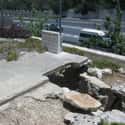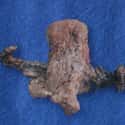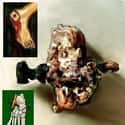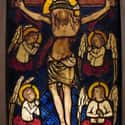-
(#1) A Stone Box Was Found Outside Of Jerusalem With A Troubling Inscription On It
Back in 1968, an archaeologist by the name of Vassilios Tzaferis had finally gotten around to excavating a group of Jewish tombs from the 1st century CE located at Giv'at ha-Mivtar in northeastern Jerusalem. There, he came across a particular ossuary, or stone box, containing the bones of the dead – essentially a coffin that would prove to be a significant discovery in support of biblical crucifixion stories.
On the outside of the box, a faint inscription was found that allegedly read, "Yehohanan ben Hagkol," or Yehohanan, son of Hagkol. Originally, this was believed to be a reference to the man's full name and family line; however, it would later be revealed that the inscription suggested something far more tragic about the contents of the box.
-
(#2) The Box Contains A Heel Bone With A Nail Driven Through It And The Bones Of A Child
Upon further investigation, it turned out that there was no record of the surname Hagkol. Instead, when compared to linguistic patterns used during the time, the word actually may have meant "crucified." This suggests that the inscription is referring to the remains of the young boy – "son of the crucified one" – who was also found inside the ossuary. The two were buried together.
Then, inside the box, archaeologists came across the first physical evidence of a crucifixion ever found – a heel bone still bearing the nail that had been used to nail it to a cross.
-
(#3) This Evidence Changed Everything We Thought We Knew About Crucifixions
Upon further investigation, researchers found that the nail used to crucify the man still had traces of olive tree wood on it, and it had bent from being nailed in. Perhaps even more significant than the evidence itself is what it tells us about the method of crucifixion. Most likely, nails were not driven through the palms of hands, and the feet were likely nailed through the heels on either side of the supporting beam.
-
(#4) The Position Of The Stake Was Evidence Of A Previously Unknown Crucifixion Technique
The position of the nail in the heel disproves much of what is known about crucifixions in the ancient world. According to The Times of Israel,
The position of the stake was evidence of a crucifixion technique that had not previously been known, according to museum curator David Mevorah. In the image of crucifixion made famous by Christian iconography, Jesus is pictured with both feet nailed to the front of the vertical beam of the cross. But this man’s feet had been affixed to the sides of the beam with nails hammered separately through each heel.
-
(#5) This Evidence Means Biblical Paintings Are Wrong About Crucifixions
In addition to the discovery that a person's heels were nailed onto the sides of the cross, the evidence gained from the remains debunks the most common religious depictions of crucifixion. Rather than having their palms nailed to the crossbeam, crucified criminals actually had their wrists bound around the top of the horizontal beam, leaving them to gradually asphyxiate due to the additional strain on the muscles used to breathe.
-
(#6) There Are Some Pretty Good Reasons For Why So Little Evidence Exists
Though crucifixion was likely first developed by Assyrians and Babylonians, it gained popularity in the Roman Empire. In fact, this method of punishing and executing criminals and political prisoners became so commonplace that the lack of material evidence of the practice has consistently frustrated archeologists and historians throughout modern history.
However, when looking at the purpose and method of crucifixion as a whole, it becomes a bit less surprising. The wood used to make the crosses, of course, is a soft organic material and quickly decomposes, so it is reasonable to expect that archeologists won't be digging up any intact crosses anytime soon. As for the nails, experts believe that they were actually collected and used as amulets by individuals who believed that they had magical and medicinal qualities. Lastly, more often than not, the individuals forced to endure this slow, painful execution were criminals being used as an example, so the burying of their bodies afterward was not of grave concern to officials or citizens. As a result, most of their remains were likely left to decompose out in the open or in trash piles.
New Random Displays Display All By Ranking
About This Tool
Nowadays, more and more ornaments are added with the element of the cross, and the cross is given a unique meaning. People believe that the necklace represents loyal love and the holy Jesus. The cross was originally a tool of torture, which can bring the greatest pain to the victim. According to legend, crucifixion was invented by the Phoenicians, and it was widely used in ancient Egypt, the Mediterranean coast, and the Middle East countries.
There are also many ways to execute crucifixion, and this cruel punishment continues to modern times. Statues and pictures of Jesus' crucifixion are widely circulated. The random tool lists 6 details of archaeological evidence that prove crucifixion was real.
Our data comes from Ranker, If you want to participate in the ranking of items displayed on this page, please click here.
















